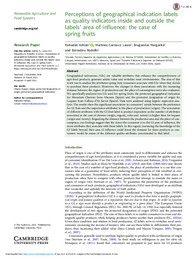Por favor, use este identificador para citar o enlazar este ítem:
https://hdl.handle.net/11000/34198Registro completo de metadatos
| Campo DC | Valor | Lengua/Idioma |
|---|---|---|
| dc.contributor.author | Martínez-Carrasco, Laura | - |
| dc.contributor.author | Rabadán, Adrián | - |
| dc.contributor.author | Brugarolas, Margarita | - |
| dc.contributor.author | Berbabéu, Rodolfo | - |
| dc.contributor.other | Departamentos de la UMH::Economía Agroambiental,Ing. Cartográfica y Expresión Gráfica en la Ingeniería | es_ES |
| dc.date.accessioned | 2025-01-07T13:47:16Z | - |
| dc.date.available | 2025-01-07T13:47:16Z | - |
| dc.date.created | 2021-04 | - |
| dc.identifier.citation | Renewable Agriculture and Food Systems 1–7. | es_ES |
| dc.identifier.issn | 1742-1713 | - |
| dc.identifier.issn | 1742-1705 | - |
| dc.identifier.uri | https://hdl.handle.net/11000/34198 | - |
| dc.description.abstract | Geographical indications (GIs) are valuable attributes that enhance the competitiveness of agri-food products, generate added value and revitalize rural environments. The aim of this work was to analyze the attributes spring fruit consumers associate with GIs when they decide to purchase these products. Moreover, the changes in these associations with the increasing distance between the region of production and the place of consumption were also evaluated. We specifically analyzed two GIs used for spring fruits: the protected geographical indication for Mountain Cherries from Alicante (Spain) and the protected designation of origin for Loquats from Callosa d’En Sarriá (Spain). Data were analyzed using logistic regression analysis. The results show the significant association in consumers’ minds between the preference for GI fruit and the importance attributed to the place of production (origin). The association of different attributes with the GI fruit label is product dependent as the number of attributes associated in the case of cherries (origin, organic, color and variety) is higher than for loquats (origin and variety). Regarding the distance between the production area and the place of consumption, our findings suggest that the closer the consumer is to the GI area of influence, the more attributes they associate with these labels. In this regard, increasing the knowledge of the GI labels beyond their area of influence could boost the demand for these products as consumers would be aware of the different quality attributes concentrated in that label. | es_ES |
| dc.format | application/pdf | es_ES |
| dc.format.extent | 7 | es_ES |
| dc.language.iso | eng | es_ES |
| dc.publisher | Cambridge University Press | es_ES |
| dc.rights | info:eu-repo/semantics/openAccess | es_ES |
| dc.rights | Attribution-NonCommercial-NoDerivatives 4.0 Internacional | * |
| dc.rights.uri | http://creativecommons.org/licenses/by-nc-nd/4.0/ | * |
| dc.subject | Cherry | es_ES |
| dc.subject | loquat | es_ES |
| dc.subject | protected designation of origin | es_ES |
| dc.subject | protected geographical indication | es_ES |
| dc.title | Perceptions of geographical indication labels as quality indicators inside and outside the labels’ area of influence: the case of spring fruits | es_ES |
| dc.type | info:eu-repo/semantics/article | es_ES |
| dc.relation.publisherversion | https://doi.org/10.1017/S1742170521000181 | es_ES |

Ver/Abrir:
Rabadán_ et al._2021_Renewable.pdf
290,17 kB
Adobe PDF
Compartir:
 La licencia se describe como: Atribución-NonComercial-NoDerivada 4.0 Internacional.
La licencia se describe como: Atribución-NonComercial-NoDerivada 4.0 Internacional.
.png)